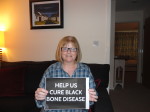
My first symptom was when my back went at the age of 32 years. Ann’s journey with alkaptonuria
Sorsha Roberts from the AKU Society speaks to Ann about her life with rare disease, alkaptonuria (AKU)
Alkaptonuria (AKU) is a rare genetic disease that causes severe, early onset osteoarthritis. AKU is also known as black bone disease or black urine disease, as these are both symptoms. It is a degenerative and often very painful disease which is caused by a build-up of homeogentistic acid in the body. Because it is so rare, diagnosis can be a long and difficult process.
At the AKU Society we aim to identify patients and bring them together, offering advice, support and even medical assessment at our National AKU Centre in Liverpool. Ann is one of these patients. I spoke to her to try and understand her experience living with the disease.
“I was in agony”
Ann was very active whilst working as a retail manager and running around on the shop floor, but after being made redundant she became a full time student. With so much sitting down and studying, her back seized.
“My first symptom was when my back went at the age of 32 years.”
After going to see a chiropractor she was told she had severe osteoarthritis in her lower spine. This is very unusual at such a young age, but Ann was unable to get her doctor to pursue it any further, and was sent away with painkillers.
“I was in a lot of pain. I was unable to lift heavy items which was problematic as I had a young daughter at the time. I couldn’t do as much as I used to and I became very cautious.”
Ann remembers one night where she got stuck in the bath due to her arthritis, “I could hardly move. I lived on my own at the time and I had to flip myself over the side of the bath. It was really scary.”
Misdiagnosis
This misdiagnosis was the first of three. Ann was next diagnosed with a blood disorder in May 2007, and sent for blood tests. When Ann had her first knee replacement five months later the bones of her joint were blackened, and she was diagnosed with pigmented villonodular synovitis (PVNS), a rare disease that effects knee and hip joints. She was told the knee replacement would solve many of the painful joint problems, but Ann’s pain did not go away. By the time she was sent for a revision, her shoulders were feeling painful too.
Ann says she found that GPs don’t have much time for their patients, and they are not experts on everything.
“Being dismissed was really hard for a long time. And really painful. But I knew something was wrong. I think we instinctively know our own bodies.”
Ann was finally diagnosed correctly at the age of 49 years after moving and changing GP. After years of not being able to understand her disease she describes it as a complete 360-degree turnaround. “It was a huge relief once I knew they had got the diagnosis right. Before I felt isolated and doubted myself. After my diagnosis I felt I was being taken seriously”
“There’s nothing bad to say about the AKU Society!”
Ann quickly got in touch with the AKU Society and was invited to the National AKU Centre in Liverpool for a full three-day assessment. Ann says this really helped her understand the progression of her disease.
When I asked Ann how the AKU Society had benefited her she said: “The peer support is incredible”.
The AKU Society has put her in contact with patients across the world through social media, patient conferences, and online communities such as PatientsLikeMe. Ann particularly recommends Patients Know Best, which allows patients to record and monitor their health records online, and securely exchange information with health professionals.
Ann now helps with teaching at Bristol Royal Infirmary every few months. The students have to take her medical history and try to provide her with a diagnosis.
“None of them have ever diagnosed me correctly!” she says.
The students then get to examine her and she teaches them about AKU. Ann explains that she loves feeling that she is helping.
“The students say they remember the experience with me a lot better than if they had just learnt about AKU from a book.”
Overall Ann has now had six joint replacement operations, and open heart surgery to remove a benign tumour that developed as a result of AKU. She says the joint replacements after her diagnosis have been more successful than those before. A researcher now attends her operations to collect tissue samples for AKU research, and Ann told me, “I have donated my body for research in to AKU after I am gone.”
![]() Click here for more on the AKU Society.
Click here for more on the AKU Society.

